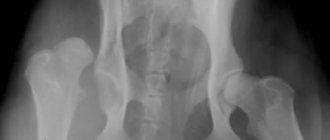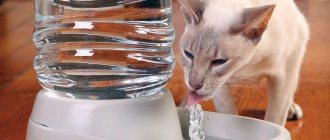Treatment methods
If lameness is caused by an infection, the cause is first eliminated.
A number of diseases, such as calcivirosis, do not have specific therapies and are treated with broad-spectrum antibiotics in combination with immunostimulants, anti-inflammatory drugs and vitamins. A cat can be prescribed a 7-10-day course of Flemoxin at a dosage of 12.5 -22 mg per kilogram of weight. Antibiotics are necessary to protect the body weakened by the virus from bacterial infections. Anti-inflammatory drugs are a common treatment for skeletal and joint problems. Non-steroidal drugs prescribed for arthritis and other disorders include Ketofen. It is often used in the form of subcutaneous injections (1% solution) or tablets (once a day). Corticosteroids are also prescribed to cats. Dexamethasone is one of the most powerful drugs in this category. The medicine is given to the animal in the form of injections (0.1-1 ml, depending on the pet’s condition), but only on the recommendation of a veterinarian. For lameness, painkillers are also used (No-spa, Papaverine, etc.).
The duration and intensity of treatment depend on the disease. Osteomyelitis disappears on its own with age. Osteochondrosis, arthritis and arthrosis often become chronic. In this case, the owner can stop outbreaks of the disease with anti-inflammatory and painkillers. In severe forms, surgical intervention is required, which may even replace the affected joint with a prosthesis.
If an animal has a fracture, the injured limb must be immobilized. Then the pet needs to be taken to a veterinarian, who will set the bone, apply a plaster cast (fixing bandage) and perform other manipulations. If the lameness is caused by a splinter, you can try to solve the problem yourself. To do this, it is better to use the help of a partner or restrain the animal, since it will not allow you to examine the paw, which is not stepped on due to a foreign body. As in humans, a splinter is removed using a needle (pin) and tweezers with preliminary sterilization of the affected area. After the manipulations, the cat will continue to limp for some time. If the paw hurts for more than a couple of hours, it is recommended to consult a doctor due to the risk of remaining splinters or injury to the limb.
Prevention of lameness
To prevent lameness due to insufficiency of vitamins and microelements, the development of arthritis, and arthrosis, the cat’s diet must be balanced. If you use dry food, then only high-quality industrial food. Before purchasing, you should carefully read the ingredients. It is necessary to limit the consumption of canned food, fatty foods, flour products, and also add more boiled vegetables.
Only a veterinarian can prescribe vitamins. Many four-legged felines are allergic to them.
Whatever the cause of lameness, it causes discomfort and pain to the patient. Trying to treat it yourself means wasting time. What if this is a serious disease that requires urgent surgical intervention? It is not at all difficult to show your pet to a specialist, thereby preserving his health, and in some cases, his life.
Source of the article: https://gafki.ru/koshki/khromaet-na-zadnyuyu-lapu-bez-vidimykh-povrezhdeniy.html
Main symptoms
In case of fractures and dislocations, the animal exhibits general clinical signs: pain, impaired motor function (lameness), swelling of the damaged area.
There are three types of fractures: closed, open, and displaced. Serious damage also includes cracks.
Signs of an open fracture in a cat:
- violation of the integrity of the skin;
- the bone is broken, its ends are displaced and protrude;
- tissue rupture in the fracture area;
- bleeding;
- strong pain.
A closed fracture without displacement is characterized by the following symptoms: the broken bone is in its usual position, the skin and tissues swell, turn blue, and turn red. In a displaced fracture, the bone diverges in different directions, and the soft tissue is partially damaged. There is a danger of internal bleeding.
A crack can easily be confused with a bruise. The bone remains intact, its edges do not diverge and are held by the intact area
The cat may move carefully but may still experience pain.
A simple dislocation is recognized by the following signs:
- skin and tissue remain intact;
- lameness;
- inability to lean on the surface;
- pain when touching the injured limb;
- The dislocated part of the body is asymmetrical.
A complex dislocation, accompanied by rupture of ligaments and tendons, is characterized by the appearance of hematomas in the injured area.
Bruises in cats, cats and kittens, degrees and prognosis for recovery
Depending on the severity of the injury, the symptoms and condition of the animal will vary. In veterinary medicine there is a certain classification of bruises by degree. There are 4 degrees of bruises in cats.
The first includes injuries that are characterized by trauma to the inner part of the skin and subcutaneous fat. Wound surfaces in the form of a scratch or abrasion may appear on the surface at the location of the bruise. The site of injury may cause discomfort to the animal, swelling and bruising may occur.
The duration of tissue regeneration in case of a first-degree injury is unusually fast and does not require the intervention of the owner or specialist.
Second-degree bruises are more often diagnosed in cats on the hind legs and are caused by falls from great heights. Such bruises are characterized by pronounced delamination and rupture of muscle fibers at the site of injury, swelling and inflammation. Such a bruise is accompanied by the development of an extensive hematoma. This type of damage sometimes provokes an increase in body temperature, a change in the rhythm of breathing and pulsation of the arteries.
A dangerous third degree injury is diagnosed quite often and poses a serious danger to the cat’s normal life, depending on the location of the injury. Third-degree bruises are most often diagnosed in the cat’s spine, accompanied by fractures and cracks of bone structures, rupture of tendon ligaments and muscle fibers.
Often, when falling from a great height, not only bones, but also joints are injured. After suffering a blow and subsequent bruise, the animal is in a state of shock. In the absence of timely assistance, death of tissue structures at the site of damage is observed. Disorders of the central nervous system are often diagnosed, especially in cases of damage to the spine and skull.
The last degree of gradation of bruises is the fourth, the most dangerous, threatening the life of the animal. With fourth-degree bruises, serious crushing of tissue structures and crushing of bones occurs. The surface layers of the skin at the site of injury are open to various pathogenic microflora.
The penetration of bacteria and fungi into the affected area leads to the development of purulent-necrotic processes, up to abscesses or sepsis. Fourth degree bruises, as a rule, occur on the animal’s limbs and it is very rare to save them. Amputation of the damaged limb and further long-term rehabilitation of the pet are carried out.
Bruises of the first and second degrees are mild, do not require special treatment, and go away quickly and independently in a few weeks. The prognosis is favorable.
A diagnosed third-degree bruise implies a cautious prognosis, and in the case of a fourth-degree bruise, the prognosis is unfavorable.
Possible causes of lameness in dogs
There can be many reasons for pathological changes in gait in dogs, but in the absence of visible damage, it is quite difficult to determine them, so the owner of the animal should contact a veterinarian. All the reasons why a dog may have a gait disorder are divided into mechanical, that is, those that were caused by external factors, and medical, which includes disorders of the musculoskeletal system.
For an accurate diagnosis, consult your veterinarian
Mechanical reasons
Most often, lameness, which arose under the influence of traumatic factors, is accompanied by external damage - wounds, swelling, abrasions, etc., but sometimes gait disturbance is the only symptom.
- Splinter. Small splinters may be invisible to a prying eye, but cause serious discomfort to the pet, which is why it begins to limp. The danger is that the foreign body often causes suppuration and abscesses, which require surgical treatment.
- Insect bites. Stings from bees, wasps, poisonous spiders and other insects are another common cause of lameness in animals. Tick bites are especially dangerous - the attached parasite not only causes discomfort when walking, but can also cause dangerous diseases, including encephalitis.
- Dislocations, sprains, fractures. If the lameness was preceded by heavy physical activity, falls or blows, the cause of the disorder may be muscle strains, joint dislocations or bone damage. Most often, representatives of large breeds with short legs and small individuals that have thin, fragile bones are susceptible to such damage.
How to remove a splinter from a dog's paw
Medical reasons
Medical causes of lameness include various diseases that are associated with dysfunction of the musculoskeletal system or other organs:
- inflammatory processes in muscle and nerve tissues;
- diseases of the central nervous system and peripheral nervous system;
- degenerative pathologies of the musculoskeletal system (arthritis, arthrosis, osteoarthritis);
- thrombosis of large vessels;
- pathologies of the spine, accompanied by compression of the nerve roots (hernia, protrusion);
- benign and malignant neoplasms;
- pathologies of internal organs, which are accompanied by pain radiating to the limbs;
- errors in nutrition, lack of vitamins and nutrients;
- overweight, too rapid weight gain in young individuals.
The causes of lameness in dogs can be various diseases.
Unobvious, but the most serious causes of lameness include genetic diseases of the musculoskeletal system, to which some breeds of dogs are susceptible - hip or knee dysplasia, muscle ataxia. These are pathologies that cannot be treated, and the only thing doctors can do is to stop the symptoms and alleviate the pet’s condition.
Diseases of the joints and bones
Joint and bone diseases appear in cats, as a rule, at 7-8 years of age - these are the first signs of aging. However, young individuals often develop ailments, many of which are transmitted genetically. Common diseases of the joints and bones of felines include arthrosis and arthritis, osteochondrosis, traumatic arthrosis, osteomyelitis, etc.
Arthrosis
Arthrosis is a non-inflammatory chronic disease. It is asymptomatic for a long time - degenerative reformations in soft tissues, bones and cartilage develop gradually. One of the common causes is a congenital defect of the anatomical structure of the animal. Mostly adults are affected, but sometimes the disease also affects young pets.
Be sure to read:
Pulmonary edema in cats: what is it, causes, symptoms, first aid, treatment, is it dangerous?
Traumatic arthrosis
Traumatic arthrosis is caused by injuries received in youth. Bruises and dislocations that go unnoticed by the owner with age lead to incorrect alignment of bones, cartilage and soft tissues. Often the cause is damage to the lumbar region. This usually happens when landing incorrectly from a height, being hit on the back with a stick, or fighting with dogs. Pinched nerve endings at such a moment lead to severe lameness and discomfort.
Reasons why a cat is limping on its front leg
In addition to injuries, some diseases also cause lameness.
Joint diseases
Joints may hurt due to calicivirus infection. The course of this disease was observed in detail in adult cats and kittens. And it has been proven that this cat cold often causes a virus to appear in the tissues of the joints, as a result of which the pet can begin to limp.
Infections
Mycoplasmosis and chlamydia in rare cases can cause lameness. In this case, the infection affects all the limbs of the animal, so it will limp on all limbs. Painful sensations appear due to infectious inflammation.
Chlamydia is often the cause of lameness
Bone tumor
Cancer, although rare, is a very dangerous disease. It is characterized by the appearance of multiple metastases throughout the animal’s body, which can result in lameness.
Arthritis and arthrosis
Arthritis is an inflammation of the joints that is common in older cats. This is an inflammatory disease that occurs as a result of pathological changes in the joints. With it, an animal at rest does not feel pain, but when walking and, especially running, the joints begin to ache. Arthritis can be identified by lack of appetite, weakness and elevated body temperature.
The main factors for its appearance:
- heredity;
- a sedentary lifestyle typical of neutered cats;
- improper diet;
- infections.
Additional Information! Poor environmental conditions may be among the causes of arthrosis. It has a negative impact not only on people, but also on animals.
Lameness after injection
Sometimes the injection may cause pain. This happens if the needle has hit a nerve, or if the medication you are taking has side effects. Usually the pain in the paw goes away after a few days.
Age-related changes
The musculoskeletal system of cats, like that of people, works worse with age. As a result, the bones become brittle and the joints wear out. This is an extremely rare occurrence, but if lameness appears in an older cat, it is worth considering this cause.
Paw problems in older cats
Back or brain injury
Sometimes pain in a limb does not always mean that the problem lies there. As a result of injury to the lumbar back or brain, the animal may begin to limp. It is likely that a nerve may be pinched, causing the animal to experience discomfort when moving.
Lack of microelements
Lameness in the limbs can occur due to a lack of useful elements, especially calcium. It is unlikely that the animal will eat so poorly, however, this reason is typical for pregnant or lactating cats, because all the nutrients they receive go to feed the offspring.
Elbow dysplasia
The disease is typical for purebred cats. It appears at a young age and progresses over the years, resulting in the cat limping on one or both front legs.
Osteomyelitis
A disease characteristic of Persian cats. With it, partial destruction of bone tissue occurs. This disease is common in young animals and can affect any limb.
Prevention
You can prevent lameness in your cat by minimizing the likelihood of injury. The main preventive measures to prevent a cat from limping are :
- monitoring what is happening to the animal while walking down the street;
- securely closing windows to protect your pet from falling out;
- adequate feeding – proper nutrition provides the animal with sufficient bone strength and tendon elasticity;
- Be careful when closing the doors so as not to slam the cat.
Reasons why a cat may limp
Most often, the reason that a cat suddenly limps is due to damage to a limb: a bruise, a fracture, a sprain, a dislocated joint, a splinter in the paw. The cause of lameness can also be the consequences of an insect bite. Overweight cats often suffer from sprained wrists when jumping poorly.
Inflammatory and degenerative diseases of the joints and spine can cause lameness in a cat. Arthritis or arthrosis in chronic or acute form leads to changes in joint tissue. The joint itself swells and its mobility is impaired. In acute arthrosis, there may be a local (in the joint area) increase in body temperature and redness of the skin. The animal's racing joints are most often affected.
Joint dysplasia is a congenital pathology caused by its underdevelopment (impaired development of connective tissue). Dysplasia, especially of the hip joints, leads to impaired mobility, lameness and severe pain when moving in a cat. The animal cannot jump onto a low obstacle (on a chair), has a wobbling gait and weakness of the affected limb. The clinical severity of symptoms is higher in Maine Coons because these animals are naturally massive and the load on the joints is higher.
Oncopathology of bone tissue often leads to compression fractures of bones. Bones can break after the most minor injury, which a healthy animal would not even notice. A classic example is an animal slipping on a slippery floor when playing or running.
Osteoporosis (decreased skeletal bone density) is a chronic systemic pathology. At the first stage it is difficult to notice. The first sign of developing osteoporosis in a cat can be considered frequent lameness caused by fractures “from scratch.” That is, as a result of almost imperceptible injuries.
Calcivirosis was identified by veterinarians as the cause of the cat’s lameness. Against the background of the usual symptoms for this infection (fever, lethargy, loss of appetite), animals, especially kittens, experience stiffness of movement and lameness. Some cats completely lose mobility and react painfully to palpation of the joint.
There may be other reasons, for example, various neuropathies (ischemic, diabetic, traumatic, etc.). These are all serious diseases, as a result of which the animal loses sensitivity of the affected limb, knee reflexes, and joint flexibility. At the onset of the disease, lameness may be a sign of the pathological process.
Vascular pathologies (thrombosis and phlebitis) can cause lameness in the animal. Thrombosis develops suddenly. The pathology is diagnosed in any cat at any age. But the risk is higher in older animals (over 8 years old) and in Persian and Abyssinian cats, as well as in Sphynxes and Maine Coons. With thrombosis, the affected limb becomes cold and loses sensitivity.
Fractures and bruises: how to recognize and what to do
If the animal constantly holds the sore paw suspended, without leaning on it at all, then this indicates a fracture or crack in the bone. The pet will not allow you to touch the sore limb and will aggressively defend it whenever possible to examine it. Usually the cat tries to remain motionless all the time - this way the pain sensations are at least slightly reduced. If you look closely, you will notice swelling of the limb and an increase in local temperature - the damaged paw will become hot. This situation requires urgent intervention.
The sore paw needs to be immobilized, but if the owner has no skills in such dressings, then it is necessary to carefully deliver the pet to the clinic, trying not to touch the damaged part of the body. It is necessary to use a carrier for this, since the sore limb should not be disturbed, and in this state the animal may become frightened and suddenly escape. Specialists will conduct an examination and take x-rays. This will allow you to determine which bone is damaged and how badly. Then a tight bandage, splint or plaster is applied to the paw - the choice is made based on the severity of the injury. The cat needs constant rest, proper nutrition and careful care until the paw is completely healed.
Bruises appear almost like a fracture, but the animal periodically leans on the affected limb. If the injury is minor, the cat will limp slightly, and after a while the signs will stop appearing altogether. With a severe bruise, the cat’s paw also does not always swell noticeably, but if you carefully compare it with a healthy limb, you can see the difference. Most often, pets will not allow you to touch the affected area, but this depends on the severity of the injury.
If your pet develops sudden lameness, you should take him to a veterinarian and consult about treatment. Many serious diseases begin to manifest themselves this way, but it is impossible to make an accurate diagnosis at home. Long-term observation and self-treatment can significantly aggravate the situation and lead to complications.
Lack of vitamins and microelements
Due to a lack of calcium and excess fluoride in the pet’s blood, hyperparathyroidism develops, muscle weakness occurs, and the skeleton is deformed. This affects the motor functions of young cats, especially kittens. The pet feels discomfort, becomes lethargic, stops playing, and moves little because the kitten’s hind and/or front legs hurt.
If measures are not taken in time, this will lead to curvature of the paws, slow growth, neurological disorders, and deformation of the skeleton (pelvic bones, chest). As soon as the owners notice signs of lameness (sagging on the hind or front legs) during the period of intensive growth of the cat, they need to show it to the veterinarian.
Since it is impossible to determine the presence of a disease based on tests alone, an x-ray will be required. It will help identify old fractures and bone destruction sites. If you take action in time, there is a chance for a successful recovery.
Treatment of lameness in cats
When you have decided on the causes of lameness in the front paw, it’s time to start treatment. It can be simple and done at home with the help of medications, for example for a minor sprain or dislocation. More serious illnesses are treated in a hospital, and surgical intervention is possible.
Drug therapy
In the case where lameness is associated with a splinter or other foreign body getting into the paw, treatment consists of treating the wound with a simple antiseptic. But first the splinter is pulled out so that swelling and inflammation do not occur. As a rule, no complications arise, the wound heals within 2-3 days. Along with painful sensations, lameness will disappear. Fractures are not uncommon in active cats. If the animal breaks its paw, you should try to immobilize it before arriving at the clinic. At the hospital, the cat will be examined and a bandage or cast will be applied.
Treatment of degenerative changes in the limbs and arthritis in cats is carried out with the help of drugs that restore the elasticity of cartilage, for example, Ketofen. It is prescribed both in tablet form (1 tablet once a day) and in the form of injections (1% solution). Medicines can only be prescribed by a veterinarian, after carrying out the necessary diagnostic measures. If pathological changes in the joints are caused by excess weight and impaired metabolism, the animal is prescribed a diet to reduce body weight.
There are cases. When it is impossible to determine the exact cause of lameness. In this case, the animal is prescribed to minimize physical activity and is prescribed anti-inflammatory drugs. Painful sensations are relieved by No-shpa, Papaverine, etc.
If lameness is caused by an infectious disease, then the root cause is eliminated first. Diseases like calcivirosis are treated with broad-spectrum antibiotics in combination with immunostimulants, anti-inflammatory drugs and vitamins. This is necessary to protect the animal’s body, which is already weakened by the disease. The doctor may prescribe a weekly course of Flemoxin at a dosage of 12.5 -22 mg per kilogram of weight.
Front paw fracture in a kitten
Surgical intervention
The duration and intensity of treatment depend on the type of disease and its advanced stage. For example, osteomyelitis disappears with age, but osteochondrosis, arthritis and arthrosis can become chronic. In this case, constant dulling of painful outbreaks with anti-inflammatory and painkillers will be required.
When lameness becomes severe, surgery is required. Depending on the situation, the doctor may decide to replace the affected joint with a prosthesis.
If the kneecap is dislocated, if timely treatment is not carried out and the disease progresses to stages 3 and 4, surgery is prescribed. The same applies to osteochondrosis. At the beginning of the development of the disease, medications are prescribed. If the lameness does not go away, but only progresses, surgery will be prescribed to eliminate the pinched nerve.
Joint diseases
Also, without visible damage, the cat limps on its hind leg with serious joint diseases. Some of them are congenital and therefore develop slowly. Pathology cannot be detected by a simple examination without medical education. If you pay attention to the accompanying symptoms and promptly contact specialists, the animal can be cured without resorting to surgery.
- Hip dysplasia is a genetic disease. It is dangerous because it can progress even in young cats. Lameness is especially noticeable after prolonged rest (sleep, rest).
- Arthritis and arthrosis are common in older animals. The disease affects bone tissue, causing pathological changes. Due to pain, cats try to move as little as possible, preferring to lie down. They often refuse food and become weak. When palpating swollen joints, they react sharply to pain. The disease may be accompanied by fever.
- Patella patellar luxation, or patellar luxation, is an uncommon problem in cats. It is usually the result of severe trauma, or less commonly a genetic abnormality. It occurs suddenly, causing severe pain in the animal. At the slightest movement of its paw, the cat meows loudly. The injury requires immediate treatment, and in advanced cases, surgery.
Lack of calcium affects the motor functions of kittens
- Osteomyelitis is a disease that occurs in young cats during the phase of active growth and development. Degeneration and partial destruction of bone tissue can affect not only one limb, but all at once. The disease is characterized by acute pain in the pet, which is why even light touches cause aggressive behavior.
- Osteochondrosis, in which pinching and compression of the nerve roots in the spine occurs, causes the animal to limp in any of the four limbs. Wear of the cartilage layer of the intervertebral discs affects the cat’s ability to move easily.
- Osteosarcoma is a malignant neoplasm. Usually it is a pathology of older cats that have crossed the 6-7 year mark.
All of these diseases can only be diagnosed by a doctor at a specialized clinic. They require mandatory treatment with corticosteroids, immunostimulating and painkillers under the supervision of a veterinarian. In severe cases - surgical intervention.
Important! If there is any suspicion of joint disease in cats, you must immediately take your pet to the clinic. Delay or attempts at treatment at home can negatively affect his health and lead to death.
Causes of lameness in cats
The pet may have no external injuries at all, and sometimes the injuries are almost invisible, but a careful examination can reveal them. If the owner notices that the cat does not step on its hind paw at all, constantly tucking it in, occasionally leans on it, or even limps a little, it is imperative to find out the reason for this. There are many factors that cause such symptoms, and these are not only injuries, but also various diseases.
A cat can limp on its hind leg without visible damage due to various injuries and pathologies in the body:
- hidden fracture;
- cracks;
- sprains;
- joint dislocation;
- splinters in the paw;
- wounds between joints;
- osteochondrosis;
- pathologies of joint formation;
- arthritis;
- osteomyelitis;
- injuries to the lumbar spine;
- arthrosis of the joints;
- osteosarcoma (oncological disease);
- hip dysplasia;
- osteodystrophy;
- dislocation of the kneecap;
- the initial stage of development of calcivirosis (viral disease);
- injection (temporary);
- claws are too long.
Why does a cat limp on its hind leg without visible damage?
Most often, cat lameness is caused by a physical injury, but some diseases and disorders can also cause pain, causing the cat to stop walking.
Visible and invisible reasons:
- fracture (closed or open);
- dislocation;
- sprained ligaments;
- improperly formed joints;
- arthrosis of the joints;
- arthritis;
- injury;
- lower back injuries;
- long claws;
- osteosarcoma (oncology), etc.
Causes of cat lameness
There are many reasons for lameness in a cat, and only a specialist can help determine an accurate diagnosis. The most common cause of sudden lameness in a cat is trauma.
Impairments in the movement of the hind or fore limb occur not only with serious injuries - fractures or dislocations, but also with minor cuts, splinters, sprains or bruises.
Other reasons are:
- Osteochondrosis
. A disease characteristic of older animals that develops when the spinal cord processes are pinched by intervertebral discs. Depending on which part of the spine has undergone a pathological process, the animal will limp. So, if the pinching occurs in the cervical region, the cat limps on its front leg. If the pinching is in the sacral region, the animal will limp on the hind limbs, on one or both at once. The disease is chronic and cannot be completely cured. Therapy is supportive, aimed at normalizing the animal’s condition and eliminating discomfort. - Arthritis
and
arthrosis
. Diseases that are more often diagnosed in older animals as a result of inflammatory processes in the joint capsule. If a cat is limping on its hind leg, inflammation may be the cause. In this case, lameness does not occur suddenly, but increases gradually. It is worth noting that ailments can affect both the hind and forelimbs of the pet. Treatment for arthritis is supportive, since there is no complete cure for the pathology. - Osteomyelitis
. A disease characterized by the destruction of bone structures as a result of a purulent inflammatory process. When osteomyelitis develops, the cat limps on the front or hind limbs. Most often, the pathological process in bone structures is observed in cats under the age of 2 years in breeds such as Persians. The opinion of scientists is that the causes of the disease are closely related to genetic inheritance. - Lameness after injection
. If a cat limps on its paw after an injection, the reason may lie in an incorrectly administered injection. The cause of lameness is damage to the nerve endings. How to properly lameness after the injection goes away after 2-3 days, but if the animal continues to limp on its paw for more than 7 days, you should consult a veterinarian. In addition to nerve damage, the injection can cause cuts in muscle fibers. This phenomenon is observed after an injection of No-Shpa. Muscle paresis goes away after 2-3 weeks, but sometimes the animal’s condition does not improve and going to the clinic would be a good idea.
- Infectious diseases
. In some cases, an infection can cause a cat to lame. Microorganisms such as mycoplasmosis and chlamydia can provoke inflammatory processes in various organs, including joint capsules. A pathological inflammatory process in the joints causes discomfort and lameness in the pet. - Spinal injuries
or
traumatic brain injuries .
When the nerve endings of the spine are pinched after an injury, a cat may experience a variety of symptoms, and in some cases the signs of pinching are barely noticeable. When the nerve roots of the lumbar region are pinched, the cat experiences lameness in the hind limbs, pinching of the cervical vertebrae, which provokes lameness in the front legs. In some cases, traumatic brain injuries are also manifested by a shaky or uncertain gait, and if the center responsible for the innervation of the limbs is disrupted, severe lameness occurs in the cat. - Malignant neoplasms
. One of the most serious causes of lameness in cats is chondrosarcoma (bone cancer). The malignant neoplasm is practically asymptomatic, but in the final stages severe discomfort, pain and lameness appear in the fore or hind limbs as a result of tumor metastasis. - Lack of nutrients
. With an acute shortage of essential microelements, especially calcium, the pet may develop degenerative processes in bone structures and cartilage tissue. Lack of microelements is especially common in cats during the period of gestation and lactation.
How is the treatment carried out?
Untreated injuries and inflammation can trigger chronic processes, leaving the cat disabled.
The treatment regimen is determined by the doctor based on the reasons why the cat presses its hind paw. Traumatic injuries are cured by applying a splint. In case of displaced closed fractures, the bone is fixed with an Ilizarov apparatus, and osteosynthesis is performed using knitting needles, medical bolts, and titanium plates. For inflammatory processes, antibiotics and physiotherapy with heat are prescribed. To restore cartilage tissue, it is recommended to add chondroitin, glucosamine and fish oil to the animal’s food. For stinging insect bites, corticosteroids are prescribed.
Diagnosis of cat lameness
What to do if you find a cat with lameness on the front or back leg? First, do not delay visiting a veterinary clinic or office. If the cause is an infectious disease, then delay in treatment can cost not only the animal’s health, but also its life. During the visit, the veterinarian will perform the following diagnostic measures:
- will look at the patient's medical history (if any). He will conduct a survey of the owner, find out whether the animal has had any injuries recently, and find out about the presence of accompanying symptoms, in addition to lameness;
- visual inspection of a limping cat. It is necessary to understand how serious the lameness is, the location of the most painful area of the limb, and the presence of abnormal places in the structure of the joints. The doctor will look at how the animal moves, runs, stands;
- neurological examination. It is carried out to exclude damage to the central nervous system, muscles, brain or spinal cord, because lameness is not always caused by orthopedic problems;
- radiograph. It will help you see the presence of cracks, tumors, growths and other problems inside the limb.
You may also need to take tests of synovial fluid, general blood and biopsy, and urine. With the introduction of the dye, studies of the spinal canal are performed - myelography. Contrast radiography or arthrography (injection of dye into the joint) is done using the same method. Ultrasound, MRI and CT may be prescribed.
The cat will get an x-ray at the veterinary clinic.











